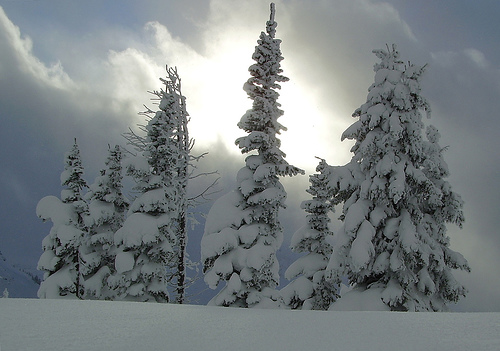It wasn’t very long ago that we got a serious snowstorm in the Washington, DC, area that was called “Snowmageddon” and “Snowpocalypse.”
Well, it’s Alaska’s turn, apparently. Here’s a news story about it from the Reuters agency:
>>An “epic” storm was bearing down on western Alaska on Tuesday, the National Weather Service said, warning that it could be one of the worst on record for the state.
The storm, moving inland from the Aleutian Islands, was expected to bring hurricane-force winds with gusts up to 100 miles per hour, heavy snowfall, widespread coastal flooding and severe erosion to most of Alaska’s west coast, the National Weather Service warned.
“This will be an extremely dangerous and life threatening storm of an epic magnitude rarely experienced,” the service said in a special warning message on Tuesday.
Nome and the rest of the Seward Peninsula, a section of land that juts out toward Siberia, are expected to be the hardest-hit areas, said Andy Brown, lead forecaster for the National Weather Service in Anchorage.
Powerful storms in the North Pacific and Bering Sea are common this time of year, but this event is unusual because of its trajectory, Brown said.
“It’s going very far north,” he said.
Posing an additional threat is the lack of sea ice off northwestern Alaska, he said. The last time a storm of a similar magnitude was sent in the same northward direction was 1974, but the sea surface was much more frozen then, he said.
“History tells that the sea ice helps subdue the storm surge,” Brown said “With no sea ice there, we could see the full brunt of that 6- to 9-foot storm surge.”
Arctic sea ice this year reached the second-lowest coverage since satellite records began in 1979, according to the National Snow and Ice Data Center in Boulder, Colorado.
Scientists there on Tuesday were watching the Alaska storm and anticipating its impacts.
“Forty years ago, a big storm like this would come through and the sea ice would act as sort of a buffer,” said Mark Serreze, director of the Snow and Ice Data Center. “The Bering Sea has and always will have these strong storms. What is different now is their potential destructiveness as you lose the sea ice cover.”
Federal, state and local agencies were making emergency preparations in advance of the storm.
The U.S. Coast Guard said it has staged helicopters in the region and sent a cutter to prepare for emergency responses, with a special focus on the crab-fishing fleet.
Numerous government agencies have set up an incident command, said Jeremy Zidek, a spokesman for the Alaska Division of Homeland Security and Emergency Management.
Nome, with 3,600 residents, is one of the largest cities in western Alaska. The communities spread along the coastline are mostly traditional Native settlements, with a few hundred to a few thousand inhabitants, and no road links between communities.
Although the region is sparsely populated, the storm presents significant dangers, Alaska Senator Mark Begich said.
“I realize we are in a remote part of the country, but many people and communities are in harm’s way,” Begich said in the statement.<<
Still, if someone lives in Alaska, he or she should expect this kind of thing!
Here’s an interesting time-lapse photography video of a recent snowstorm in Centreville, Virginia:
« Are Soy Meals ‘Cruel And Unusual’ Punishment? ‘My iPhone Isn’t Working!’ »

